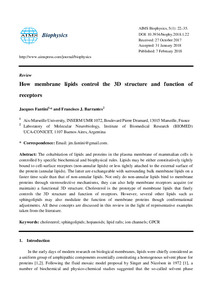Por favor, use este identificador para citar o enlazar este ítem:
https://repositorio.uca.edu.ar/handle/123456789/1439| Campo DC | Valor | Lengua/Idioma |
|---|---|---|
| dc.contributor.author | Fantini, Jacques | es |
| dc.contributor.author | Barrantes, Francisco José | es |
| dc.date.accessioned | 2019-05-02T13:56:11Z | - |
| dc.date.available | 2019-05-02T13:56:11Z | - |
| dc.date.issued | 2018 | - |
| dc.identifier.citation | Fantini, J., Barrantes, F.J. How membrane lipids control the 3D structure and function of receptors [en línea]. AIMS Biophysics. 2018, 5 (1). doi: 10.3934/biophy.2018.1.22. Disponible en: https://repositorio.uca.edu.ar/handle/123456789/1439 | es |
| dc.identifier.issn | 2377-9098 (online) | - |
| dc.identifier.uri | https://repositorio.uca.edu.ar/handle/123456789/1439 | - |
| dc.description.abstract | Abstract: The cohabitation of lipids and proteins in the plasma membrane of mammalian cells is controlled by specific biochemical and biophysical rules. Lipids may be either constitutively tightly bound to cell-surface receptors (non-annular lipids) or less tightly attached to the external surface of the protein (annular lipids). The latter are exchangeable with surrounding bulk membrane lipids on a faster time scale than that of non-annular lipids. Not only do non-annular lipids bind to membrane proteins through stereoselective mechanisms, they can also help membrane receptors acquire (or maintain) a functional 3D structure. Cholesterol is the prototype of membrane lipids that finely controls the 3D structure and function of receptors. However, several other lipids such as sphingolipids may also modulate the function of membrane proteins though conformational adjustments. All these concepts are discussed in this review in the light of representative examples taken from the literature. | es |
| dc.format | application/pdf | es |
| dc.language | eng | es |
| dc.language.iso | eng | es |
| dc.publisher | AIMS Press | es |
| dc.rights | Acceso Abierto | es |
| dc.rights.uri | https://creativecommons.org/licenses/by-nc-sa/4.0/ | es |
| dc.source | AIMS Biophysics. 2018, 5 (1) | es |
| dc.subject | COLESTEROL | es |
| dc.subject | LIPIDOS | es |
| dc.subject | PROTEINAS | es |
| dc.title | How membrane lipids control the 3D structure and function of receptors | es |
| dc.type | Artículo | es |
| dc.identifier.doi | http://www.aimspress.com/article/10.3934/biophy.2018.1.22/fulltext.html | - |
| dc.identifier.doi | 10.3934/biophy.2018.1.22 | - |
| uca.path | Facultad de Ciencias Médicas|Instituto de Investigaciones Biomédicas (BIOMED UCA-CONICET) | es |
| uca.disciplina | MEDICINA | es |
| uca.filename | /home/data-uca-generic/folder_generic/IIBiomedicas/how-membrane-lipids-control/metadata.xml | es |
| uca.issnrd | 1 | es |
| uca.affiliation | Fil: Fantini, Jacques. Aix-Marseille University. Institut national de la santé et de la recherche médicale; Francia | es |
| uca.affiliation | Fil: Barrantes, Francisco J. Pontificia Universidad Católica Argentina. Facultad de Ciencias Médicas. Instituto de Investigaciones Biomédicas. Laboratorio de Neurobiología Molecular; Argentina | es |
| uca.affiliation | Fil: Barrantes, Francisco J. Consejo Nacional de Investigaciones Científicas y Técnicas; Argentina | es |
| uca.version | publishedVersion | es |
| item.grantfulltext | open | - |
| item.fulltext | With Fulltext | - |
| item.languageiso639-1 | en | - |
| crisitem.author.dept | Instituto de Investigaciones Biomédicas - BIOMED | - |
| crisitem.author.dept | Laboratorio de Neurobiología Molecular | - |
| crisitem.author.dept | Facultad de Ciencias Médicas | - |
| crisitem.author.orcid | 0000-0002-4745-681X | - |
| crisitem.author.parentorg | Facultad de Ciencias Médicas | - |
| crisitem.author.parentorg | Instituto de Investigaciones Biomédicas - BIOMED | - |
| crisitem.author.parentorg | Pontificia Universidad Católica Argentina | - |
| Aparece en las colecciones: | Artículos | |
Ficheros en este ítem:
| Fichero | Descripción | Tamaño | Formato | |
|---|---|---|---|---|
| how-membrane-lipids-control.pdf | 497,57 kB | Adobe PDF |  Visualizar/Abrir |
Visualizaciones de página(s)
254
comprobado en 30-abr-2024
Descarga(s)
268
comprobado en 30-abr-2024
Google ScholarTM
Ver en Google Scholar
Altmetric
Altmetric
Este ítem está sujeto a una Licencia Creative Commons

